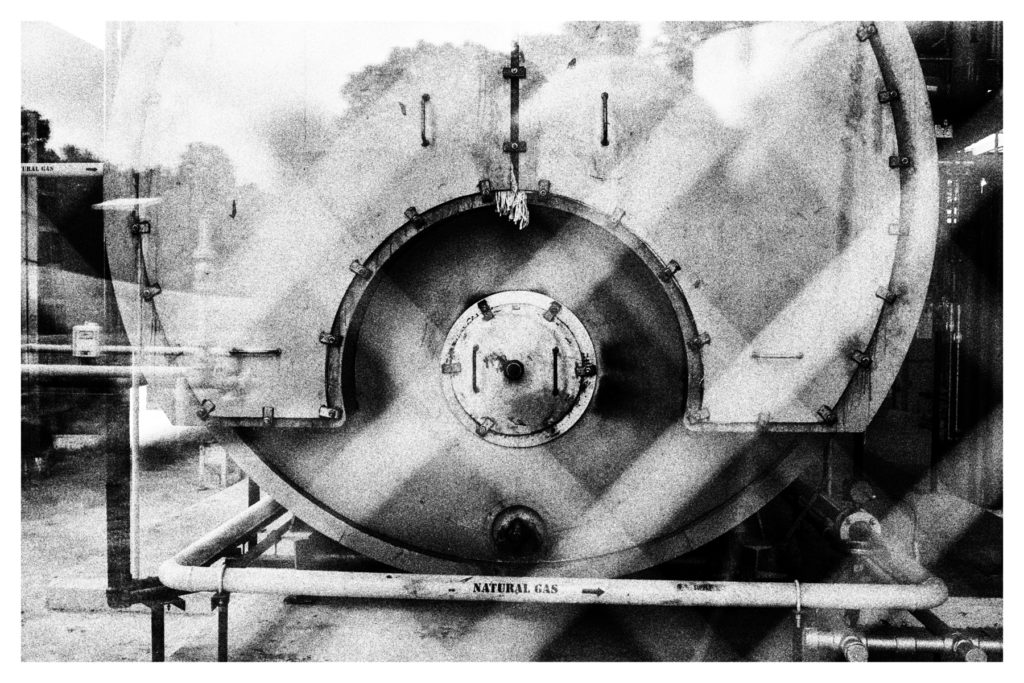
The Classic B&W Film Look – Shot with a Sigma DP2x
If I’ve made one concession to the digital age, it’s that it’s sent me on a quest to duplicate, via digital capture, the classic B&W film look. By ‘film look’ I mean the ’50s era Tri-X aesthetic. I’m not interested in grainless, subtle tonalities coupled with optical perfection. Leave that to digital B&W, almost all of which, to my eye, just doesn’t look very interesting. It looks thin and plastic, like it has no depth. I could be imagining things, but I don’t think so. The differences are real, and, at least to me, they matter. B&W photography, if it’s worthy of the name, should have a certain look. Think Robert Frank’s Americans, or Josef Koudelka’s Gypsies, or Trent Parkes’ Minutes to Midnight.
Above is a photo I took recently with a Sigma DP2x, post-processed in Silver Efex. To me, it’s a film image – the contrast, the grain, the tonality of Tri-X developed in Rodinal – about as close as I’m going to get without actually running a roll of Tri-X through my camera. So, it can be done. For comparison, I’ve posted a film snap below that exhibits the characteristics I’m looking to duplicate digitally. To my eye, these two photos could have come from the same roll.
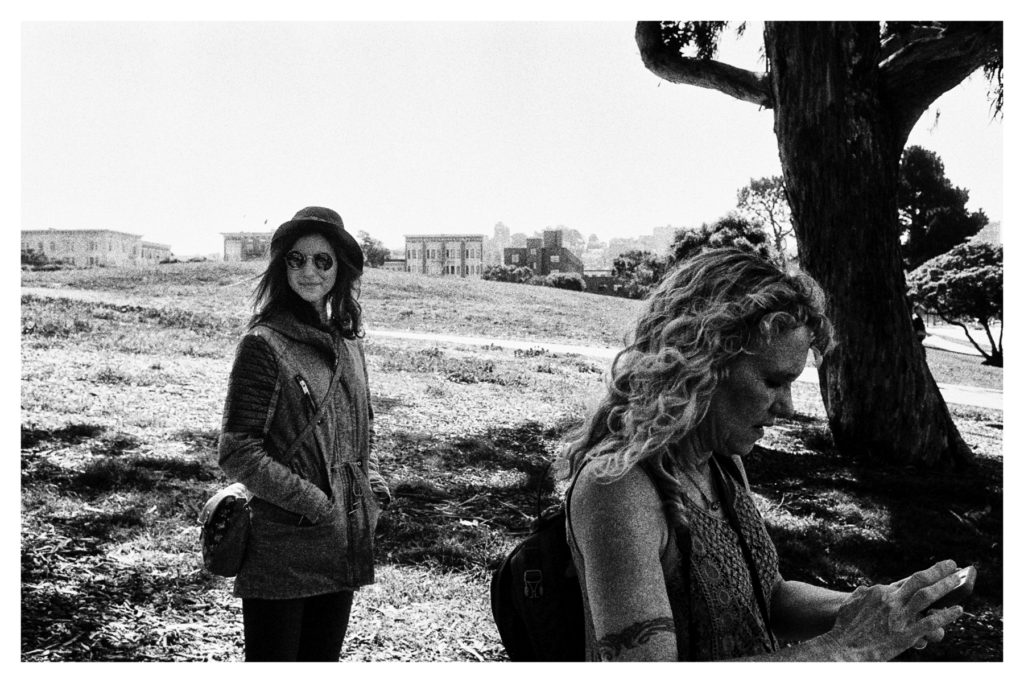
Valentina and Donna, San Francisco, 2016 – HP5 at 800 ISO.
*************
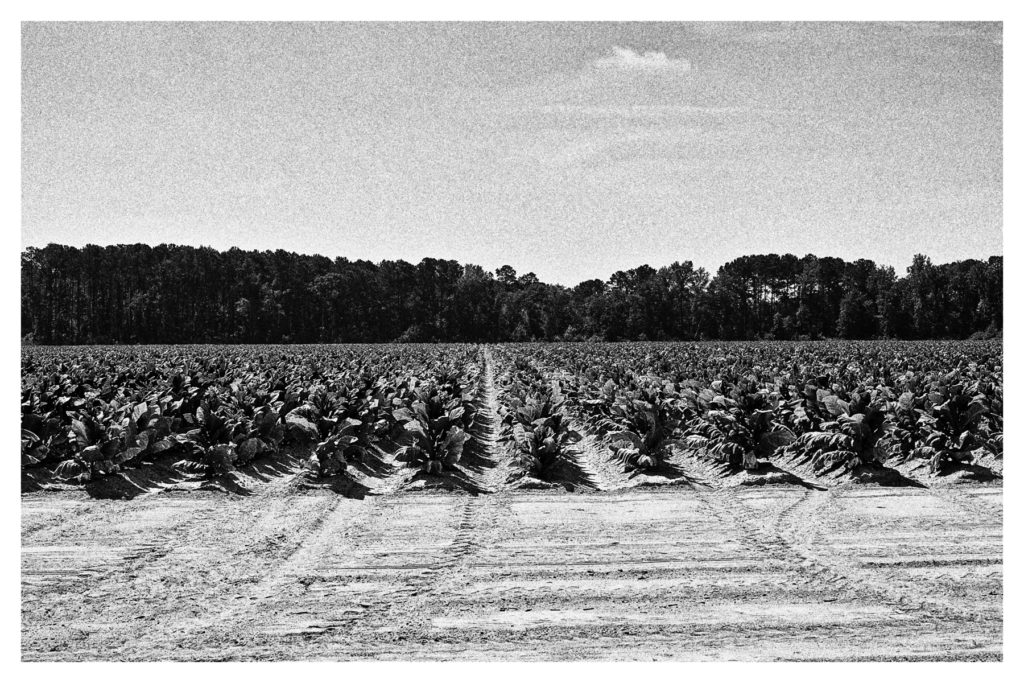
Tobacco Fields, Eastern North Carolina – Film or Digital? Hard to Tell (It’s a DP2x Silver Efex Conversion)
What I’ve learned [so far] can be distilled into a few simple observations: First, you’ve got to shoot RAW and run your files through film emulation software. No B&W jpegs using various in-camera film simulations. Pushing digital ISO and relying on digital noise isn’t going to get it either. I find Silver Efex to be excellent, especially using the Tri-X, HP5, Neopan 1600 and TMax 3200 presets as starting points.
Second, relatively low-resolution sensors give better film simulations; grain structure seems more accurate, tonalities more amenable to Tri-X contrast. 5-12 mpix seems to be the sweet spot. Something about higher resolution sensors – 24 mpix and above – translates into unnatural looking grain structure when post-processed, a look of having been added-on as opposed to being an organic characteristic of the output. It makes sense – 35mm Tri-x and HP5 aren’t about resolution so much as a particular grain patina. High-resolution output can’t be disguised with a simple grain overlay. The original Sigma Dp series – the 5 mpix Foveon – gives remarkably film-like grain output and tonality, printable up to 11×14 (which, ironically, is about the same limit of enlargement allowed by a 35mm negative, supporting the argument for the approximate equivalency of the Dp resolution to that of 35mm film), when run through Silver Efex by a discerning eye. It’s 35mm Tri-X developed in Rodinal in a digital box. Other sensors that seem to effectively simulate film output are the 10 mpix CCD sensor of the Nikon d200 and, my favorite, the 12 mpix Ricoh GXR M-mount. The beauty of this is you don’t need to spend $4000 on a Monochrom; you can pick up a d200 or d80 for next to nothing, and pre-digital Nikon primes are cheap as dirt.
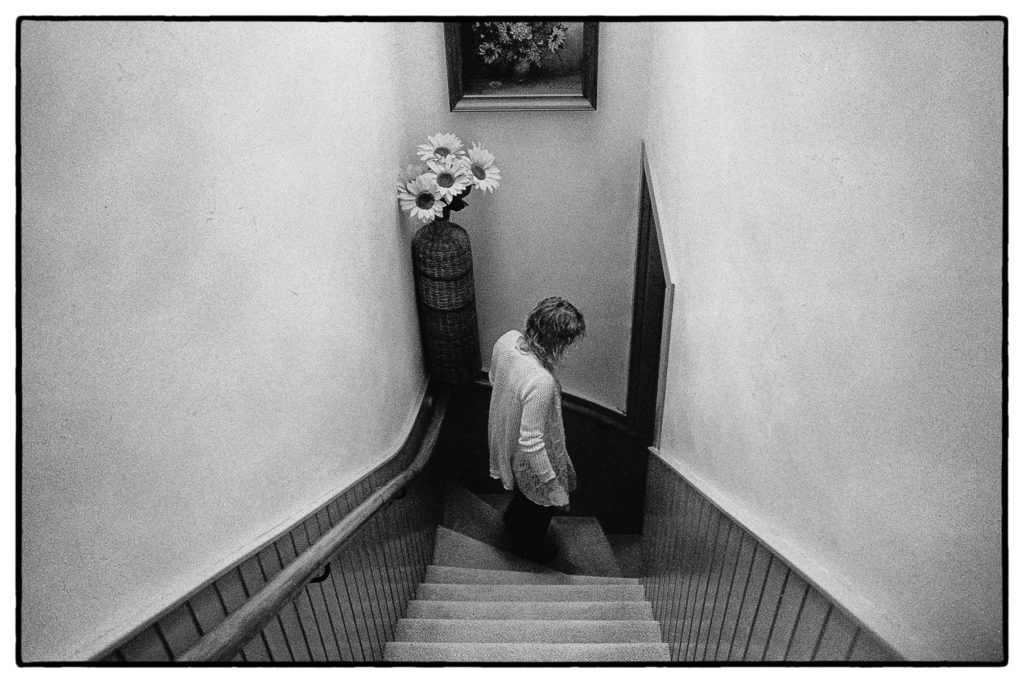
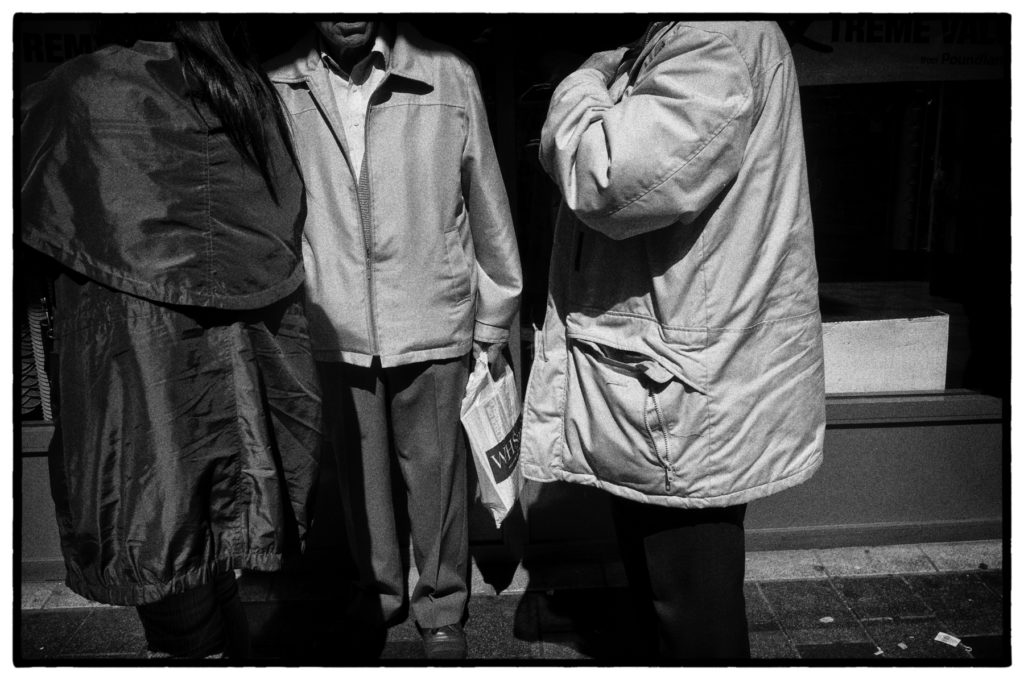
One’s Film (HP5 2 800 ISO). One’s Digital (Ricoh GXR M-Mount).
Which leads me to my third generalization: film era optics produce better digital files for film emulation. Highly corrected modern digital optics are simply too sharp if you’re looking to replicate film. Film didn’t look that way, a function of less tack-sharp optics. Older lenses were designed using manual computation, are inclined to flare a bit and are often softer at the edges or have some vignetting, things you don’t see in modern, highly corrected optics. These optical characteristics are also a part of what we think of as the ‘film look.’
*************
I’ve recently bought the camera a CCD Monchrom. Leica marketed it as an evolution of B&W film photography in the digital age. They bundled a copy of Silver Efex with it, just in case. I’ve not had it long enough to make any valid comparisons, but first impressions are excellent. At the very least, it does capture B&W in a way unlike traditional digital B&W output. Below are two Monochrom snapshots run through the same emulation as the DP2x shots, followed by two similar DP2x shots.
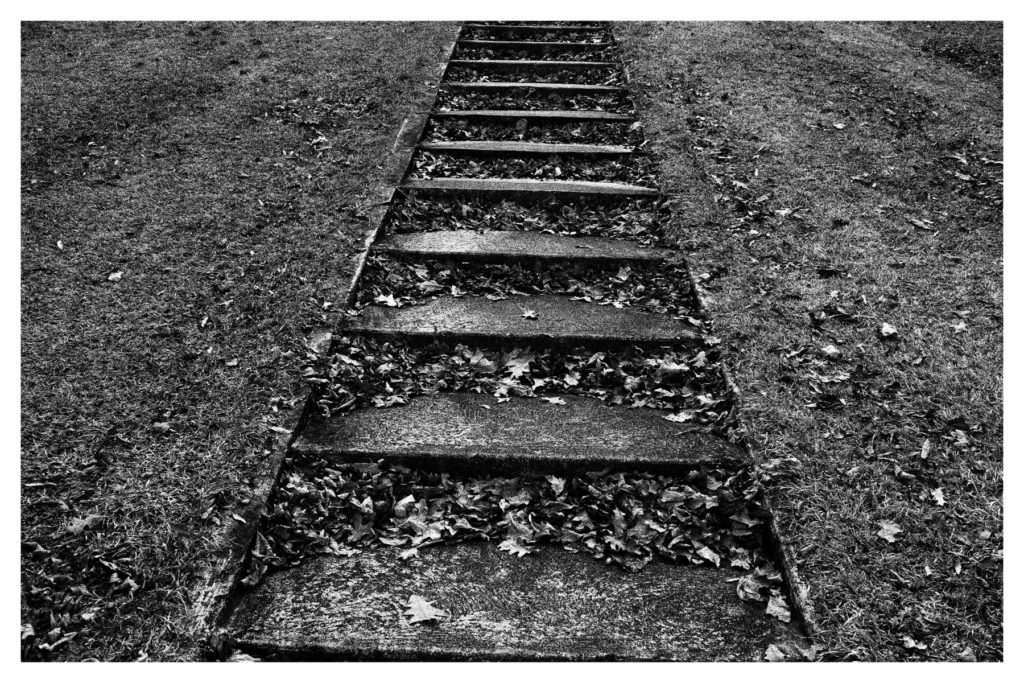
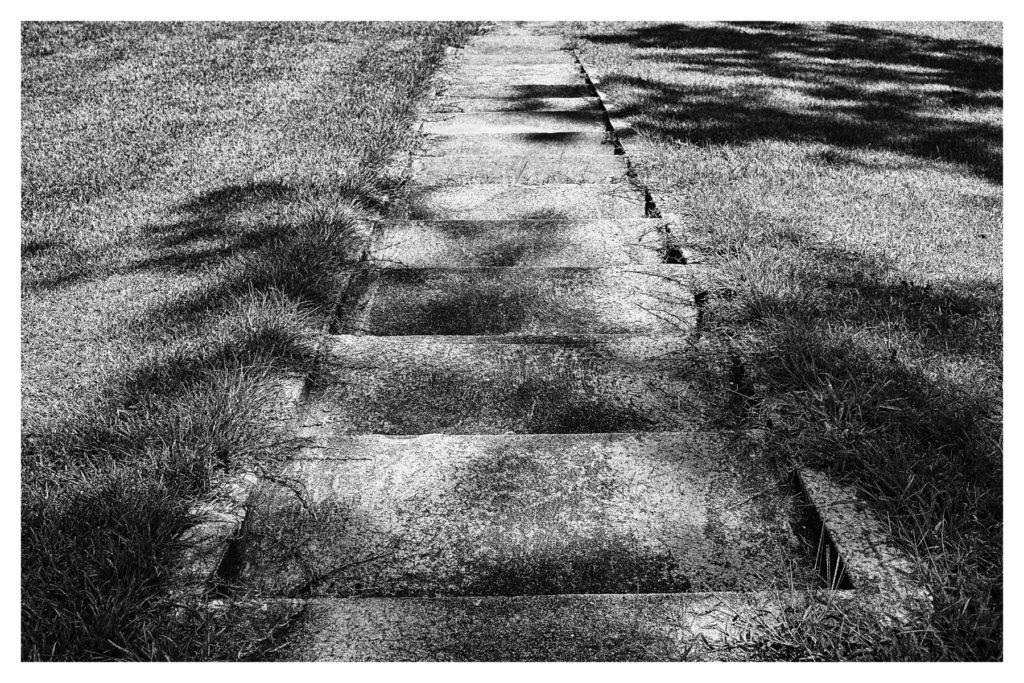

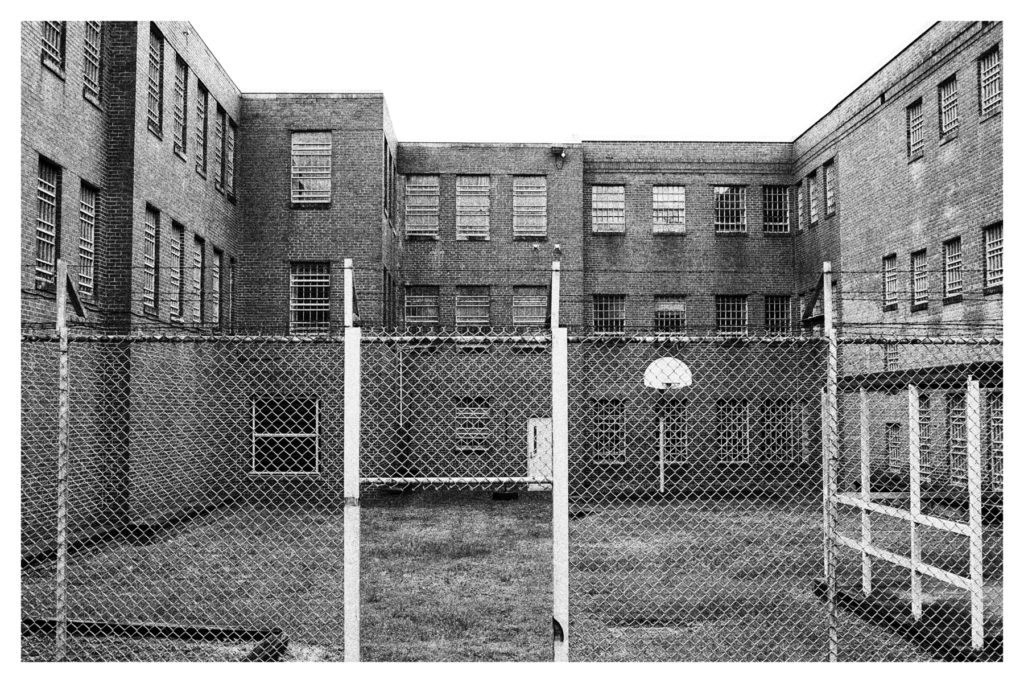
Views: 59

I agree that film has a certain look and your emulations are excellent. Apart from my iPhone I shoot film because I’m a cheapskate so I inevitably get the film look.
But *cough cough* some of us are still waiting for the big reveal on the post “This is not a trick question” of 15 December, was it film or was it digital 🙂
Good to see the new posts and hope you are well.
I can’t remember that far back, Bill. What was your take on it?
In your picture of Buddy, Donna and Abby at Carolina Beach I thought it was digital because the grain on the horizon neatly aligned with the horizon instead of being random. I suggested with Pan F there could also have been random white dots of missing emulsion as well but I couldn’t see any missing bits. But that’s all I had.
You’re right. It was shot with a Sigma sd Quattro. It’s too sharp to be film iMO. the Sigma Foveons are hyper-sharp.
Thank you for the information. The results are really impressive, I liked the tonality of the picture and the moment that was captured. Cheers.
As a starting point I’d be interested to see a direct comparison between the unadulterated raw files of the older Leica CCD sensor Monochrom cameras and the newer CMOS sensor versions.
Anyone fortunate enough to own both?
Thing is, there appears to be a basic confusion here about film.
Film was never meant to offer any particular pattern of granularity. The effort was always to eliminate grain from making its grand entrance into images as much as humanly and chemically possible.
Fast film was developed with one objective in mind: to allow good, clean exposures under low lighting conditions. That the many abuses and misuses of the medium gave rise to visible grain structures was nothing but a sad result of basically bad technique, often caused by desperation to catch something rather than nothing. As mentioned before, it was sometimes the result of star egos that thought themselves beyond the need of exposure meters. The best developing agent that I discovered was plain old D76 diluted 1+1 with water. If you underexpose and then try to compensate by overdevelopment, of course you get grain; why would you do that unless in extreme conditions, which is not something that current snappers are in when then try to emulate so-called filmic looks: they try to do it under good lighting conditions.
I often used HP3/4 in my various Nikons, and when printed up on 8″x10″ those prints revealed none of the highly exaggerated grain pattern that exponents of digitally induced grain seem to seek as some Holy Grail, some reference back to the glories of film. I have never seen grain in film-sourced prints as bad as is shown in small, digital images online.
Gentlemen, you are in grave danger of trying to copy and sanctify the worst errors and abuses of film photography!
😉
Very interesting. I think you may be right. We’ve elevated the results of bad technique into a characteristic of the genre. I must say that I was always a half-assed developer – time/temp requirements being elastic in my mind. As such, I got grainy negs. I use a two bath Diafine developer these days which isn’t really that sensitive to temp/time variations, coupled with pushing the film a stop or two (as recommended when using Diafine) and my negatives come out grainy, just the way I like them. I do think that your claim of grainlessness being the goal back in the day is wrong though; we put up with grain as a necessary condition, sometimes more, sometimes less, but always there in some form, rather than seeking to avoid it completely.
I would add some qualification to that. If I have a file from the M246, say a portrait with a white background transitioning to a skin tone, adding grain does ease the transition. That may not be critical at 16mp or 18mp but if I’m using a Sonnar 50 1.5 at 24mp I do find that it can get quite ‘digital’ even if the Sonnar is ‘soft’.
Don’t see the point in faking film with digital… You want a film look (grain, contrast, etc)? Use a film.
Easy enough to say. And I do use a lot of film. But it’s a PITA. Sometimes I want easy…but I also want that film look. Thus, the Monochrom and my continuing attempts to find a means to duplicate it as best as possible. I think I’ve gotten to the point where I can produce a digital shot that looks ALMOST indistinguishable from a film shot scanned on my 6 mpix Pakon scanner.
Of course, all of this talk of the film look ignores the fact that film scanned looks different from film wet printed. I guess what I’m seeking to duplicate is digital files that print out like film scanned and then printed.
If the films no longer existed, I could understand the process even if I don’t like it. But it is not. It’s like having fun tweaking digital photos to look like paintings. Pretty ridiculous, isn’t it?
You’re right. Film still exists. Why not just use it? [glancing to my left at a XL ziplock bag full of rolls of undeveloped HP5}.
I can’t help feeling this is going in the direction of those who listen to the hi-fi system rather than the music.
I like the allegory keith. Using film by day and wet printing by night makes me a melomane.
For sure Tim knows pretty much what he’s looking for, he wont slip all the way.
By the way i’m writing this listening to a miles vinyl.
I thought it was more akin to Dylan Goes Electric…..
Below, a link to a huge crop from a Plus X negative shot, back in ’66, on my Ekakta Varex 11a. The lens was a 135mm Tele-Schneider (that was an f3.5 creature, I think). It was the first lens that I bought for that camera at the time, having an obsession with headshots. The shot was made across a void, the girl leaning against some kind of a steel railing thing.
http://www.roma57.com/uploads/4/2/8/7/4287956/ultimo-22-and-23_orig.jpg
The grain is very visible because I couldn’t get close to measure anything on that particular shot. The neg was too heavy, dense, which kinda proves what I said earlier about bad technique! With trannies, it would have been a cinch: just measure the Sun from the same direction as it hits the subject, right from where I was standing…
Also, Plus X was not a film I used much; it was a stand-in for Ilford’s FP3, enough of which I didn’t have with me that day. A secondary point that this raises is this: a maker’s ASA is just a base from which to start and formulate your own sense of what that specific ASA represents to you, a thing that varies very much on how you measure exposures. When you habitually measure a specific kind of tone in a subject and base your exposure on that, you are starting to create your own idea of film speed, which is what happens if you ignore grey cards and all that stuff. I never knew anybody who used them. I always exposed my black/whites for the important shadow areas – usually that meant the darkest important part of a dress or coat or whatever. If you habitually measure another part of a scene, a lighter part, for example, you have already fed your meter information that alters the effective ASA that you’ve set. Measuring different parts of the very same subject, with your meter at the same ASA setting, results in different exposures on the film, which scews with the idea of a given ASA. Hence why people rate their films higher or lower, and think they are pushing them or not. It all boils down to metering, and your standard technique for doing that.
That’s why any developer maker’s advice about pushing film so many stops is doubtful: they have no idea how you actually use your film, how you use its speed rating, nor even what your standad soup might be… that’s why you first have to test and test your fim and chosen developer until you know the combination very well.
I have before me Don McCullin’s eponymous book with the tight crop of the shell-shocked marine, a dramatic cover image. Open the book and you find very, very little grain on show; as I have read it, he always used a meter, even on the front lines, saying that to screw up exposure when in such dangerous situations made no sense at all, defeated all the trouble to which you’d gone to make the photos.
But anyway, I do actually like grain sometimes, if it suits the shot. No client ever did; it’s also why Bailey’s first New York shoot for Vogue had him pretend he’d used LF when he’d used 135 fomat, presenting the editors with enlargements instead of contacts. Or so the tale goes, thought I kinda wonder where myth takes over from fact with some of these tales of and from the rich and famous.
Rob
Then again you’ve got Salgado putting his digital back onto film….grain he says.
Rob, I admire your knowledge, all of it borne of hard-won experience no doubt. Your thoughts on ASA/metering are spot on, and I’m sure have been reached after much trial and error on your part but…., when all is said and done, did it really matter? I knew all the stuff, in theory, but frankly, my technique was always just set the damn camera on something close to a proper exposure (the sunny 16 rule and its varients helped) and develop it in d76 at something resembling 68* and you got what you got. Controling for tones? Way over my head. Maybe that’s why I could never be a pro…I just never could develop professional chops.
Funny thing, I usually got good negatives in spite of my retched technique. I do pretty much the same thing with digital. Frankly, I rarely look at an exposure meter. Intensity of light has been hard-wired into me by 50 years of shooting mostly without a meter.
As somewhat of an aside (although related), I get a great kick out of guys on forums extolling the need for newer cameras with more dynamic range because it allows them to rescue badly exposed snaps in post in a way you couldn’t with, say, a D200. For God’s sake, are you that incompetent that you cant manage to expose within a stop or two of a ‘proper’ exposure? What are these guys doing – playing roulette with their aperture dials?
But, whatever. Back to my point (I think): Sometimes we overthink things, I suspect.
“But it’s a PITA. Sometimes I want easy…but I also want that film look.” Translation: sometimes I want to eat at Macdonalds and pretend to myself that it is real food’. But it isn’t, is it?
Things that are easy are, ultimately, not satisfying. I suspect that this is why you keep posting these teasers about film vs digital. There is a DigiTim that is happy to go out shooting with a monochrom/ricoh/d200 and to spend time with the computer files to create a simulation of a real photograph, and there is a FilmTim who knows that is not really photography. Digital is the ghostly doppelganger of real photography.
You’re on to something, Gavin. And, for the record, one of the great joys of life is sitting down to a meal of 3 MacDonald’s Hamburgers, large fries heavily salted, and a large Vanilla shake. Heaven. Call me white trash, I don’ care. (And you wonder how I got stomach cancer?)
From someone who spent time in France, that’s a terrible confession!
That said, even the French support that multinational monster. You can spot them now and again as you pass some towns whilst you are driving along the motorways. Another American feature I’ve noted there is the phenomenon of ribbon development on the outskirts of towns; a specialty seemed to be plastic swimming pools up on one side, so folks passing them could admire the full beauty and depth of blue plastic.
Rob
Wait until they start the placing, usually in the front yard, of used porcelain toilets as a rose planter.
Just as long as they have been carefully washed before going on display…
😉
As somebody whose name now escapes me remarked about the movie industry: nobody knows anything.
😉
“Other sensors that seem to effectively simulate film output are the 10 mpix CCD sensor of the Nikon d200 and, my favorite, the 12 mpix Ricoh GXR M-mount. The beauty of this is you don’t need to spend $4000 on a Monochrom; you can pick up a d200 or d80 for next to nothing, and pre-digital Nikon primes are cheap as dirt.” Tim
Regarding the D200, currently – and probably for ever – my last working digital camera: the colour shot below was at whatever is the highest ISO to which I can crank it. The girl was inside the entrance of a shop and I hadn’t time to get closer and fill the frame a bit more, so it’s also a crop. (I believe it to be from the D200, but God knows where I stored the original file. However, there is no doubt about knowing and feeling at the time that the camera I was using didn’t go high enough up the ISO scale.)
So does it look “painterly” or is it just a terrible, digital mess? At first I thought it an indictment of digital cameras, and then I grew to like it on its own terms.
If that can happen to the photographer, what chance any viewer of getting the correct opinion, whatever correct means?
http://www.roma57.com/uploads/4/2/8/7/4287956/gps-pgs-40-and-41_orig.jpg
With all due respect Rob, it’s a ‘digital mess.’
It’s at least 50% my feeling too!
🙂
Thanks for sharing; been down the exact same path myself, Sigma cameras are like light to a moth. They drag you in and then you get burned … and then go back closer, again and again; i have owned – and sold – several DP cameras, 1 and 2, S, X, a couple of SDs (the SD1 was actually great, for a DSLR). The Foveon look is magnetic, no doubt, but the slow handling and quirkiness of the cameras make them hard to deal with on a daily basis. However, the sensor itself is the reason why images look so “filmic”, the stacked construction is as close as you can get to how film is made.
The Monochrom was probably the best camera I have ever owned, and I curse the day I sold it; I am trying to get one again soon; the only “flaw”? Files look too perfect at times (the obsession with higher and higher megapixel numbers has consequences!).
In an ideal world, we would have full frame Foveon sensor (one with and one without colour filters) inside an M body. The quest for a perfect camera would finally be over.
Yeah, been there. I’m currently looking to buy a dp1 to replace the dp2x I sold recently. That 5 mpix Foveon sensor is just magic for b&W. As for the Mono, yes, it CAN be too perfect; the DNGs definitely gain by being dumbed down in Silver Efex, no doubt.
Oh dear. Interesting … For me the darkroom is the ”killer app”, if we are ever allowed out of these lock-downs to go back to them. So you have spent all this time painstakingly recreating synthetic grain (although Tim my tri-x in Rodinal doesn’t look like the above) … then what do you do with the file? How do you get it onto the baryta paper? Every time I take a digital image I find myself thinking this … Hmm… Actually there is a technological solution for that too, Picto here in Paris will … wait for it … scan a laser beam of your digital file onto photographic paper and then (automatically) develop it for you. I am not convinced it would look as good as a real negative printed with a 100 euro enlarger … and that’s surely a long path between when the photon arrived and when the paper got dark.
« The darkroom is the killer app » i share that virus with you mr McCracken. Haven’t understood yet how your friends slowed down a photon and trapped it, although very briefly. They got a Nobel for that. Me i’m noble at best… i still use film to do that. Pour la petite histoire, i met them in Montreal few years back and i thank them for what they did.
“I often used HP3/4 in my various Nikons, and when printed up on 8″x10″ those prints revealed none of the highly exaggerated grain pattern that exponents of digitally induced grain seem to seek as some Holy Grail, some reference back to the glories of film. I have never seen grain in film-sourced prints as bad as is shown in small, digital images online.” Rob Campbell
Exactly, Henry, as my earlier post, quoted abpve, also remarked! Real grain from films never did look like the simulations. It was usually hard to spot with small pints; it began to show on 8″x10″ prints when technique had been faulty. But I do not remember it as being this harsh, crisp-looking sandpaper effect that even small digital reproductions show. Also, it did not appear on blown highlights: those simply printed solid white.
I may be turning cynical, but I believe that a lot of modern technology makes its claims in the hope that the younger buyers to whom it is marketed will not know about the original things that the new replace.
Small pints? Umm… no beer references intended; please read prints rather than pints!
😉
All I know, Henry, is the prints you recently graciously sent me are beautiful. You clearly know your way around the darkroom. I’m not sure why our respective Tri-X in Rodinal look different, however. Parisian versus North Carolina water?
“Exactly, Henry, as my earlier post, quoted above, also remarked! Real grain from films never did look like the simulations. It was usually hard to spot with small prints; it began to show on 8″x10″ prints when technique had been faulty. But I do not remember it as being this harsh, crisp-looking sandpaper effect that even small digital reproductions show. Also, it did not appear on blown highlights: those simply printed solid white.”
I think you’re exactly right on this. If you did see grain it was extremely tight, but more importantly, to the experienced eye, you expected to see it.
Then there is the Daido Moriyama grain-in-your-face shot. I don’t love it or hate it but sometimes I simply don’t get it. Other shots, it works…..
The criteria I use has more to do with the expectation for that particular shot where I would expect to see grain based on film experience rather than an additive effect.
I read
vinyl
is best
but digital
is better
in 8 bit
and
added
scratch and rumble simulation.
Really? Wow.
It must be art, it sounds sh*t.
“It must be art, it sounds sh*t.”
It, “art”, often is. Especially in today’s market.
Enjoyed this series of pictures:
https://www.youtube.com/watch?v=EjEjrnjoa-8
a nice way of reviewing a camera – by making photographs! How novel!
In this instance, the M10 Mono.
I’ve had the M Monochrom since Dec 2012. My second digital monochrome camera. The first- about 20 years older than the new one. When the M9 first came out, called Kodak and asked about them making a monochrome version of the camera. Preaching to the choir. So when it came out almost 3 years later, had to buy one. As far as emulating a film look- I wrote by own software in FORTRAN-77 to process the DNG files, and a Gamma curve, and store back with 16 bits/pixel instead of 14 bits. With everyone owning Digital cameras, you’d think more people would be writing their own software to get the look they want.
A sobering note: a few days ago, on French tv, there was a report of a French “cloud storage” building burning down, with the loss of a great deal of other peoples’s files, these being lost for ever. Unless badly stored, film does offer a greater sense of security. I wonder what sort of legal liabilities might be involved in such cases?
Negatives and trannies have always felt more certain… but then, if folks don’t ever experience them, how are they to understand? A bad thing about film, though, is getting rid of it when it no longer serves any purpose. I faced that situation when we decided to migrate to Spain, and I had sold to old clients the film that they might care to keep for their company archives. The rest of it took a helluva lot of work and sore fingers with the scissors. Could hardly burn it in the garden like the late Brian Duffy did his, but on the other hand, I wish, today, that I had kept all of it.
I am starting to wonder if it’s truly dyslexic fingers (as self-defined),or actually a slipping clutch inside the mind: peoples’s? Really?
Oy friggin’ vey.